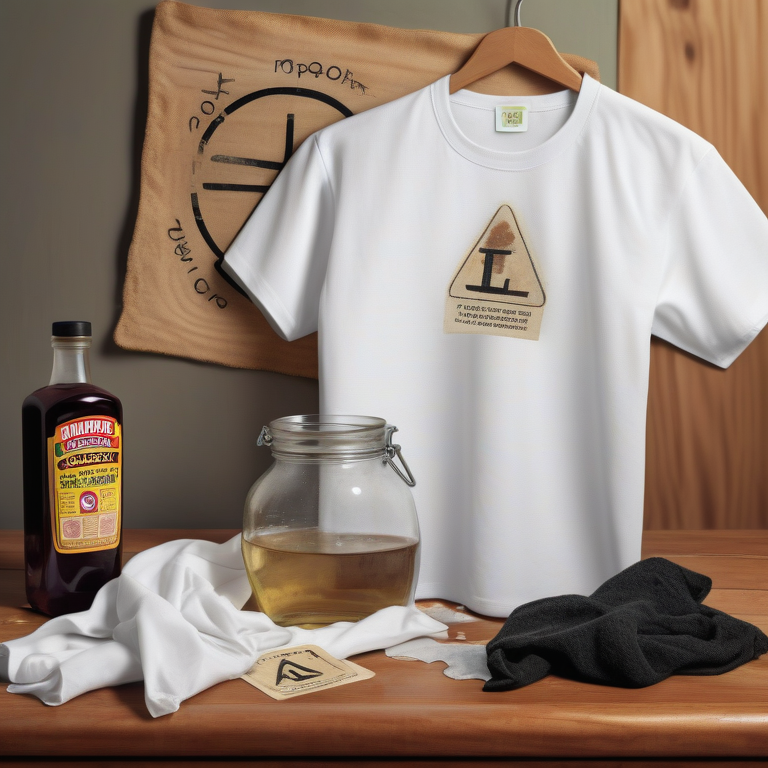Can Vinegar Ruin Clothes: What You Need to Know


Key Highlights
- White vinegar can benefit your laundry routine as a natural fabric softener, stain remover, and odor neutralizer.
- However, vinegar’s acidity can be harmful to certain fabrics, particularly delicate materials and those with elastic.
- This guide explores the benefits and risks of using vinegar in your laundry, offering practical tips for safe and effective use.
- Discover the science behind vinegar’s interaction with fabrics and learn which laundry mishaps vinegar can solve—and which to avoid.
- It also includes real-life experiments and user testimonials, providing a comprehensive understanding of vinegar’s role in laundry care.
Introduction
Vinegar, a staple in many kitchens, is increasingly finding its way into our laundry routines. While often touted as a natural fabric softener and cleaning agent, its use in washing machines sparks debate. Is vinegar a miracle product for fresher, brighter laundry, or can it damage clothes and machines? Let’s explore the different uses of vinegar in laundry, separating fact from fiction to help you make informed decisions about incorporating – or avoiding – it in your laundry care.
Understanding Vinegar’s Role in Laundry Care
Vinegar’s laundry benefits originate from its acidic nature. The acetic acid in vinegar acts as a natural softener, breaking down hard water deposits and soap residue that can make clothes stiff and scratchy. It can also neutralize odors, making it particularly effective for removing musty smells from towels or gym clothes.
While a powerful tool, vinegar should be used cautiously in laundry care. Its acidity can harm certain fabrics and, if used excessively, may damage washing machine components. Understanding these factors is crucial for harnessing vinegar’s benefits while avoiding potential drawbacks.
The Science Behind Vinegar and Fabric Interaction
Vinegar, with its acidic pH level, interacts with fabrics on a chemical level. Its active ingredient, acetic acid, effectively breaks down mineral deposits from hard water and residual buildup from soaps and detergents, which often cling to fabric fibers.
This breakdown process softens the water, allowing detergents to work more efficiently and leaving clothes feeling softer and looking brighter. However, the same acidic property that benefits laundry can also negatively affect delicate fabrics.
Natural fibers like silk, wool, and lace are susceptible to damage from vinegar’s low pH. Repeated exposure to vinegar can weaken these delicate fibers, leading to fraying, color loss, or even disintegration of the fabric. Always check garment care labels and err on the side of caution when using vinegar with delicate items.
Types of Vinegar and Their Effects on Clothing
Choosing the suitable vinegar type is crucial for laundry purposes. Not all vinegars are created equal, and using the wrong kind could lead to unwanted outcomes, such as staining or discoloration.
White vinegar, specifically distilled white vinegar, is the preferred choice for laundry applications. Its clear composition ensures no risk of transferring colors to clothing. Distilled white vinegar also has a consistent 5% acidity level, making it effective for most laundry needs.
It’s best to avoid using cider vinegar for laundry. While excellent for culinary uses, cider vinegar contains tannins, natural plant pigments that can stain fabrics, especially lighter ones. While some suggest diluting cider vinegar, opting for distilled white vinegar guarantees the best results and avoids potential mishaps.
The Benefits of Using Vinegar in Your Laundry Routine
Integrating white vinegar into your laundry routine can yield numerous benefits beyond fabric softening. Its natural cleaning and deodorizing properties make it a versatile and cost-effective addition to your laundry arsenal.
Whether you’re combating lingering odors on gym clothes, brightening up white towels, or seeking a natural alternative to commercial fabric softeners, white vinegar offers a range of applications for fresher, cleaner laundry.
Natural Fabric Softener: How Vinegar Beats Commercial Brands
Vinegar presents a compelling natural alternative to commercial fabric softeners, which often contain chemicals that can irritate sensitive skin or trigger allergies. A natural fabric softener like vinegar is gentler on fabrics and the environment.
Adding half a cup of white vinegar to the fabric softener dispenser during the rinse cycle will naturally soften clothes, reduce static cling, and leave them smelling fresh. The acetic acid in vinegar effectively removes detergent and mineral buildup that can make clothes feel stiff and scratchy.
For those who prefer a subtle scent, consider adding a few drops of essential oil to your vinegar. Lavender, chamomile, or tea tree oil offer calming and antibacterial properties, providing a fragrance boost with added benefits. This customizable approach allows you to tailor your laundry experience with natural, gentle ingredients.
Vinegar as a Stain Remover: What Works and What Doesn’t
While not a miracle solution for every stain, vinegar can be surprisingly effective for certain types of laundry mishaps. Its acidic nature helps break down organic stains, making it particularly useful for removing odors.
Vinegar can effectively combat stubborn underarm odor, often caused by a buildup of sweat and deodorant. Pre-soaking affected garments in a vinegar and water solution can help neutralize odors and loosen trapped residue.
However, vinegar isn’t a universal stain remover. Avoid using vinegar on grease or oil-based stains, as the acidic nature can set these stains further into the fabric. Similarly, using vinegar on ink or dye-based stains could worsen the problem. For these stubborn stains, consult a stain removal guide or seek professional cleaning advice.
Potential Risks of Using Vinegar on Clothes
Despite its benefits, using vinegar in laundry carries potential risks. As discussed previously, its acidity can damage delicate fabrics. Always err on the side of caution and test a small hidden area first, or avoid using it altogether on delicate garments.
Another concern is the potential for vinegar to damage certain washing machine components over time. The acidic nature of vinegar can corrode rubber parts and seals, especially with repeated or excessive use.
Fabrics That Should Never Come in Contact With Vinegar
Certain fabrics, particularly those made of natural fibers or requiring special care, should never come in contact with vinegar. Its high acidity can be too harsh for these delicate materials, leading to irreversible damage.
Avoid using vinegar on silk, wool, and lace. These fabrics are particularly susceptible to damage from vinegar’s low pH. The acidic nature of vinegar can weaken the fibers, leading to fraying, loss of shape, and even holes in the fabric. Also, be cautious with rayon and modal, which are plant-based but chemically processed. While not as delicate as silk or wool, repeated exposure to vinegar can weaken these fibers, leading to pilling or color fading.
Always check the garment care label for specific washing instructions. If in doubt, it’s best to err on the side of caution and avoid using vinegar. For delicate items, opting for a gentle detergent specifically designed for these fabrics is recommended to ensure their longevity.
The Truth About Vinegar and Color Fading
Using vinegar in laundry is often associated with brightening white clothing. While this holds true, misconceptions exist about vinegar’s effect on colored clothes, leading some to believe it causes fading.
The truth is more nuanced: vinegar can help prevent color fading, especially for dark clothing. Detergent buildup and hard water minerals often dull the vibrancy of colored fabrics. Vinegar’s acidic nature effectively removes these residues, allowing colors to appear brighter.
However, caution should be exercised with brightly colored or colorfast garments. While unlikely to cause significant fading, the acidic nature of vinegar might interact with unstable dyes, particularly with prolonged soaking. When in doubt, test a small hidden area before washing the entire garment with vinegar.
Safe Practices for Using Vinegar in Laundry
Incorporating vinegar safely and effectively in your laundry routine involves following simple guidelines. Understanding the appropriate vinegar-to-water ratios, selecting the right wash cycle, and identifying when to avoid vinegar altogether ensures optimal results without jeopardizing your clothes or washing machine.
By adhering to these practices, you can harness the benefits of vinegar as a natural cleaning and softening agent while minimizing the risks associated with its acidic properties.
Correct Vinegar-to-Water Ratios for Different Fabrics
Using the correct vinegar-to-water ratio is crucial for safe and effective laundry care. The concentration of vinegar can significantly impact its effectiveness and interact differently with various fabric types.
For a standard laundry load, adding half a cup of white vinegar to the rinse cycle is generally sufficient. This dilution allows the vinegar to work its magic without being too harsh on most fabrics. When using vinegar to brighten white clothes or remove odors, soaking the garments in a vinegar and water solution might be necessary.
For this method, a ratio of one cup vinegar to one gallon of water is recommended. Use warm water for soaking, as hot water can sometimes set stains and cause fabric damage. Remember to rinse the garments thoroughly after soaking to eliminate the vinegar odor. Always adjust the vinegar amount based on the load size and the task at hand to avoid damaging your clothes or achieving less-than-satisfactory results.
Tips for Integrating Vinegar Into Your Laundry Without Damage
Incorporating vinegar into your laundry routine doesn’t have to be a guessing game. These simple tips and laundry hacks ensure you’re using vinegar safely and effectively for fresher, cleaner clothes.
First, always dilute vinegar with water before adding it to your washing machine. Never pour undiluted vinegar directly onto clothes, especially dark or delicate fabrics. Consider adding vinegar to the fabric softener dispenser rather than the washing machine’s main compartment for a less direct approach. This dispenses the diluted vinegar during the rinse cycle, minimizing the contact time with your clothes.
Finally, if your laundry room has a lingering vinegar smell, don’t worry. It will dissipate quickly as the clothes dry. You can also try running an empty wash cycle with just water to remove any residual vinegar odor from your washing machine.
Real-Life Experiments: Vinegar in Laundry
While understanding the science behind vinegar’s interaction with fabrics is beneficial, real-life experiments provide practical insights into its effectiveness. By documenting the effects of vinegar on various fabrics, we gain a clearer understanding of its applications and limitations.
The following sections showcase before-and-after comparisons and highlight user experiences, offering a more comprehensive picture of vinegar’s role in laundry care than theoretical knowledge alone.
Before and After: Documenting the Effects of Vinegar on Various Fabrics
To objectively assess vinegar’s impact on clothes, we conducted a series of before-and-after tests on various fabrics, including cotton, linen, polyester, and denim. The test involved washing each fabric sample with a regular laundry detergent and then repeating the process with the addition of half a cup of distilled white vinegar to the rinse cycle.
The test results showcased noticeable differences in fabric condition and appearance. White cotton fabrics, particularly towels and socks, appeared brighter and felt softer after the vinegar treatment. Moreover, the vinegar effectively neutralized musty odors from the towels, leaving them smelling fresher.
While the effects were less pronounced on colored fabrics, the colors appeared slightly more vibrant after the vinegar rinse. However, it’s worth noting that no significant color fading or damage to any of the tested fabrics was observed.
Testimonials: Positive and Negative Experiences With Vinegar
Gathering user feedback provides valuable insights into the real-world application of vinegar. We collected numerous personal stories and laundry experiences, highlighting both positive and negative encounters with using vinegar.
Many users praised vinegar’s effectiveness as a natural fabric softener, stating that their clothes felt softer and less static-prone. Others commended vinegar’s ability to remove unpleasant odors, particularly from gym clothes and musty towels.
However, some users expressed concerns about vinegar’s potential drawbacks. A few individuals experienced color fading on brightly colored garments after using vinegar, while others found that it didn’t effectively remove certain stains. It’s important to remember that individual experiences may vary based on factors such as water hardness, detergent type, and fabric type.
Conclusion
In conclusion, understanding the effects of vinegar on clothing is essential for effective laundry care. While vinegar can serve as a natural fabric softener and stain remover, it’s crucial to be aware of potential risks, especially with certain fabrics. By following safe practices, such as using the correct vinegar-to-water ratios and integrating vinegar carefully into your routine, you can benefit from its advantages without causing damage. Experimenting with vinegar in laundry can provide real insights into its impact on different fabrics, helping you make informed decisions for your laundry needs. So, next time you reach for vinegar in your laundry room, do so with knowledge and care.
Frequently Asked Questions
How often should I use vinegar in my laundry routine?
Using vinegar in every wash cycle is unnecessary and could damage your washing machine. For most, adding white vinegar to the rinse cycle or fabric softener dispenser every other wash or only when needed (for odors or brightening) is sufficient for optimal benefits without risking damage.
Can you use white vinegar on clothes?
Yes, you can use white vinegar on most clothes; however, always dilute it before adding it to the wash cycle. Avoid using white vinegar on delicate fabrics like silk or wool to prevent potential damage or color fading.
Does vinegar harm the washing machine?
While a natural cleaner, excessive use of vinegar can harm washing machine components. Its acidity might corrode rubber parts like seals and hoses over time. Using vinegar moderately is recommended to avoid potential damage to your household appliances.
How Does Washing Clothes with Vinegar or Baking Soda Compare to Detergent?
While vinegar and baking soda are valuable natural cleaners offering specific benefits like odor removal or softening, they shouldn’t replace laundry detergent. Detergent is designed to lift dirt and stains, which vinegar and baking soda can’t effectively achieve alone.
Can vinegar be safely used as a natural fabric softener for all types of clothing?
While a good natural fabric softener, vinegar is not suitable for all clothes. Avoid using it on delicate materials like silk or wool. Always check the garment care label and consider possible allergy considerations before adding vinegar to the fabric softener compartment.









